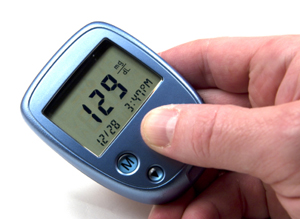May 23, 2011
A Look at Hyperglycemia

By Michael D. Shaw
Hyperglycemia is defined as “an abnormally high concentration of glucose in the circulating blood.” Fair enough, but what’s normal?
Since this concentration will vary during the day in healthy individuals, the focus has been directed more at fasting and postprandial (following a meal) levels. Inasmuch as the most common cause of hyperglycemia is some form of diabetes, guidelines have long been in place to define the level that constitutes a diagnosis of diabetes. Unfortunately, there was—and still is—a significant amount of politics, and what we might call incomplete science involved with these numbers.
Over the relatively recent past, for example, the fasting blood (technically plasma) glucose numbers that define diabetes have gone from 161 mg/dL (8.9 mmol/L), to 141 mg/dL (7.8 mmol/L, and down to the current standard of 126 mg/dL (7.0 mmol/L). The most widely quoted authority on this matter is a paper entitled “Report of the Expert Committee on the Diagnosis and Classification of Diabetes Mellitus,” published in the January, 2002 edition of Diabetes Care.
Presumably, the glucose concentration chosen for a diagnosis of diabetes is based on the levels that are known to cause complications, including retinopathy, nephropathy, and neuropathy. However, to put it mildly, there is controversy on this issue, along with skepticism of the supporting research.
Self-styled health activists will cite studies suggesting that retinopathy could be associated with fasting levels as low as 120 mg/dL (6.7 mmol/L), and decry that the glucose tolerance test (once the gold standard) has been removed from common use. On the other side are those who realize that a diagnosis of diabetes carries a serious stigma, including permanent “rated” status of life and health insurance policies. Thus, they eschew setting the bar too low.
Indeed, many who have cured their supposed type 2 diabetes—or who at least have returned their fasting blood glucose to normal levels without drugs—are dismayed to discover that their insurance status will not be affected. Talk about a scarlet letter.
Further complicating matters, there is no agreement as to which test methods should be employed, with some experts recommending the A1C value over simple blood glucose testing.
A1C is a form of your blood’s hemoglobin that is glycated (coated with sugar). It is generally agreed that a percentage of A1C ≥ 6.5 (48 mmol/L) is indicative of diabetes. Given the 120-day life cycle of a red blood cell, the A1C assay offers a much longer-term view of the blood glucose situation. However, attempts to correlate the A1C with a supposed “average” blood glucose level are fraught with difficulty.
Ironically, some in the pro-A1C camp—including Mayer Davidson MD, author of a February, 2011 article in Diabetes Care entitled “Diagnosing Diabetes With Glucose Criteria: Worshipping a False God”—believe that the current glucose levels are set too low.
Finally, we must note the emergence of a genuine diabetes industry. Consider these astonishing numbers from the National Institutes of Health…
Diabetes affects 25.8 million people of all ages; 8.3 percent of the U.S. population; DIAGNOSED 18.8 million people; UNDIAGNOSED 7.0 million people. And, how about the 79 million people with so-called “pre-diabetes”? Heck, I have a friend who was recently warned that he has “borderline pre-diabetes”!
If you dig deep enough, though, you will discover that Type 1 diabetes accounts for about 5 to 10 percent of diagnosed diabetes in the United States. Thus, somewhere between 940,000 and 1.9 million people have the much more dangerous Type 1 form of the disease, which requires daily insulin therapy, and tends to present the most complications. It is noted by some authorities that many—or even most—type 2’s do not develop complications to anywhere near the extent of the type 1’s.
But, from a marketing point of view, lumping them in with the type 1’s sure creates a bigger cohort, doesn’t it? There are those who question whether type 2 is even a disease at all. Rather, they say, it is a result of lowering acceptable blood numbers to create more sick people and sell more drugs.
If you don’t quite believe that, consider that there is no agreement on whether type 2 can be cured. You would think that since the signal symptom of the condition is elevated blood glucose, getting it down to normal levels without drugs would define a cure. Think again.
A popular website for type 2’s is run by a man who claims that he presented to an emergency room with a blood glucose level in excess of 500 mg/dL (27.8 mmol/L), was diagnosed with type 2 diabetes, was put on a shopping bag full of drugs, and was sent home. Gradually, he says, by micromanaging his diet, he was able to get his numbers down to 75 mg/dL (4.2 mmol/L), without drugs. He blames his profound hyperglycemia on excessive consumption of sweets.
A host of certified diabetes educators will tell you that type 2 cannot be cured, and that you can’t eat yourself into those sorts of numbers, as a normal individual’s insulin production would counteract even the most absurd diet.
I have a different explanation. This man ate himself into chronic hyperglycemia, and by improving his diet, got his numbers down. He never had diabetes.
Bearing in mind that stress and inflammation can easily put your numbers above the “diabetic” level, how many so-called type 2’s are merely temporarily hyperglycemic? Good question, only don’t expect a straight answer from those in the industry.

